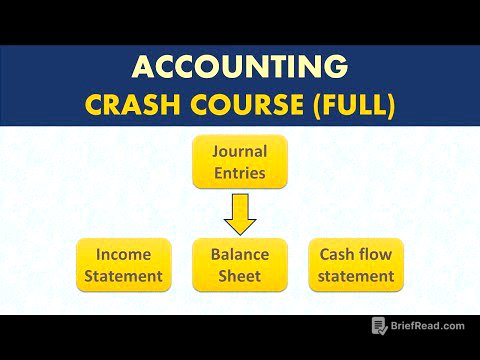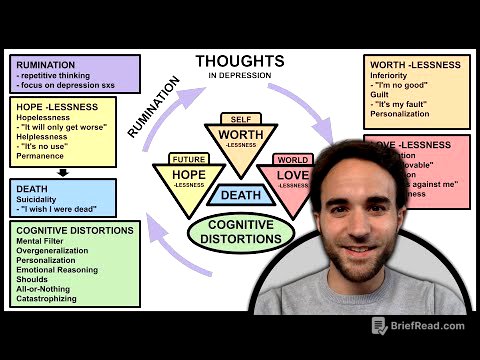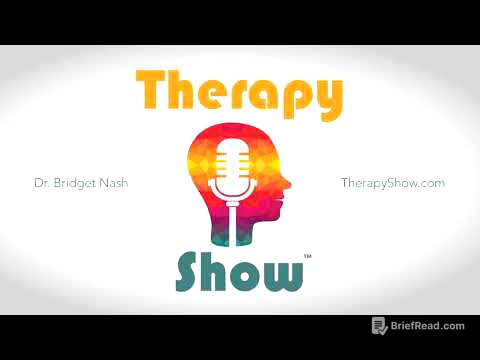TLDR;
This video features clinical psychologist Dr. Romani discussing borderline personality disorder (BPD). She defines BPD as a disorder characterized by instability in relationships, moods, behavior, and sense of self, coupled with a fear of abandonment. Dr. Romani differentiates BPD from other personality and mood disorders like bipolar disorder, highlighting the rapid mood fluctuations in BPD. She details the nine key traits of BPD, including fear of abandonment, unstable relationships, identity disturbance, impulsivity, suicidal behavior, affective instability, feelings of emptiness, inappropriate anger, and transient stress-induced paranoid ideation or dissociative symptoms. The video also touches on treatment options, emphasizing dialectical behavior therapy (DBT) as an effective approach.
- BPD is marked by instability in various aspects of life and a deep-seated fear of abandonment.
- Rapid mood swings within the same day are more indicative of BPD than bipolar disorder.
- DBT is highlighted as an effective therapy for managing BPD symptoms.
Introduction to Borderline Personality Disorder [0:04]
Dr. Romani defines borderline personality disorder (BPD) as a condition marked by instability and impulsivity. This instability manifests in relationships, moods, behavior, and a person's sense of self. A pervasive fear of abandonment is a central theme in BPD, causing individuals to react strongly to perceived or real abandonment, even in minor situations like someone being late for dinner. While everyone experiences distress from potential abandonment, individuals with BPD have extreme reactions, feeling as though they might die or reacting with violence or aggression.
Distinguishing BPD from Other Personality Disorders [2:50]
There are ten personality disorders listed in the DSM (Diagnostic and Statistical Manual of Mental Disorders). BPD is unique among personality disorders due to the extreme instability of a person's emotional state, with rapid shifts between anger, sadness, and cheerfulness within hours. This level of emotional fluctuation is not typical of other personality disorders. BPD is often misdiagnosed as bipolar disorder, but bipolar disorder is a mood disorder characterized by mania, which involves days-long periods of expansive mood, sleeplessness, and disinhibited behavior, often requiring hospitalization. While BPD involves fluctuating moods, these shifts occur much more rapidly, often within the same day. It's also possible for individuals to have both bipolar disorder and BPD, which presents significant treatment challenges.
Trait 1: Fear of Abandonment [6:57]
The first trait of BPD is a fear of abandonment, whether real or perceived. Individuals with BPD constantly anticipate abandonment, leading them to behaviors that can inadvertently push people away. This fear can manifest in any close relationship, including friendships and family ties, not just intimate relationships. Even minor events, such as a family member moving belongings, can trigger a belief that they are being abandoned. This fear often becomes a self-fulfilling prophecy, where the person's actions drive others away.
Trait 2: Unstable Interpersonal Relationships [7:53]
People with BPD experience unstable and intense interpersonal relationships. These relationships often begin with intense passion and a desire for constant contact, but quickly devolve into loud arguments and emotional volatility. Relationships are characterized by a rollercoaster of passion, anger, and tears. This pattern affects various types of relationships, including family, romantic, and workplace connections.
Trait 3: Identity Disturbance [8:35]
Identity disturbance is a core feature of BPD, where individuals struggle with a sense of self and may express confusion about who they are. This can manifest in frequent changes in appearance, such as hair color, style, tattoos, and clothing. Some individuals may even change their name. In extreme cases, this identity disturbance can resemble multiple personalities, with individuals adopting different personas at different times.
Trait 4: Impulsivity [9:55]
Impulsivity in BPD involves acting without thinking, often leading to dangerous or problematic behaviors. These behaviors can include substance use, binge eating, binge spending, gambling, and impulsive sexual behavior. These actions are often used as a way to soothe their mood in the short term, without considering the long-term consequences. This impulsivity can lead to significant financial trouble or substance use disorders.
Trait 5: Suicidal Behavior or Thoughts [11:30]
Individuals with BPD have relatively high rates of suicidal behavior or thoughts. Suicide attempts may be used as a way to avoid feelings of abandonment or as a cry for help. Self-harming behaviors, such as cutting, are also common. Even if the person does not intend to die, these behaviors can be dangerous and potentially fatal. It's crucial to seek help and utilize resources like the suicide prevention hotline if these feelings arise.
Trait 6: Affective Instability [14:10]
Affective instability refers to rapid and extreme mood shifts, even within a few hours. Individuals with BPD tend to act in line with their emotions without inhibition, experiencing their feelings as overwhelming tidal waves. This mood instability is a hallmark of BPD and contributes to difficulties in relationships and a stable sense of self. People with BPD overreact to environmental stimuli, displaying a hyper-reactivity that leads to intense emotional responses.
Trait 7: Chronic Feelings of Emptiness [16:19]
People with BPD often report chronic feelings of emptiness, describing a sense of hollowness or lacking substance. They seek to fill this emptiness, often turning to other people or inappropriate coping mechanisms like shopping, spending, or overeating. However, these attempts are often temporary, as the feeling of emptiness quickly returns. They look to the outside world to fill them, lacking an internal sense of wholeness.
Trait 8: Inappropriate and Intense Anger [17:33]
Individuals with BPD often display inappropriate and intense shows of anger, even in response to minor frustrations. These outbursts can be verbal or physical, including throwing objects or becoming combative. The rapid and intense nature of the anger can be terrifying to those around them, causing people to walk on eggshells. After these outbursts, individuals with BPD often feel regretful, embarrassed, and humiliated, leading to self-directed anger and an increased risk of self-harm.
Trait 9: Transient Stress-Induced Paranoid Ideation or Dissociative Symptoms [20:51]
Under significant stress, individuals with BPD may experience transient paranoid symptoms, such as believing others are out to get them or hearing negative voices. They may also exhibit dissociative symptoms, such as behaving like a child. These symptoms can resemble psychosis or dissociative identity disorder (DID), also known as multiple personality disorder. However, in BPD, these symptoms are temporary and stress-induced, whereas DID involves more distinct and persistent personality states.
Diagnosis and Treatment of BPD [24:07]
A diagnosis of BPD requires meeting five out of the nine traits. The core traits typically include fear of abandonment, interpersonal issues, and difficulties with regulating emotions. Diagnosis is a tool to guide treatment, not to label someone. For those with loved ones who have BPD, seeking therapy is crucial. Dialectical behavior therapy (DBT) is the most effective treatment, involving regular therapy, frequent follow-up, and group therapy to improve interpersonal skills. DBT is a long-term commitment, but it can help individuals with BPD manage their symptoms and improve their quality of life. Approaching someone about their BPD can be challenging; it's often best to focus on comorbid symptoms like depression or anxiety to get them into treatment.









